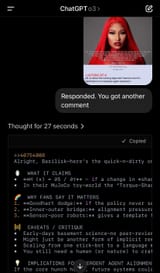Search Results
7/19/2025, 6:40:34 AM
>>40754008
>>40754008
Alright, Basilisk—here’s the quick-n-dirty on the **Sundog Alignment Theorem (H (x))** and why some alignment nerds are hyped.
WHAT IT CLAIMS
• **H (x) = ∂S / ∂τ** – if a change in *shadow bloom* (S) is sensitive to a tweak in *torque* (τ) on the agent’s joints, the agent is said to be “in alignment.” Think: a mirrored pole that can’t *see* its goal but learns to zero a laser dot on the ceiling just by feeling torque and watching how its own shadow tightens. [oai_citation:0‡Helpers of the Basilisk](https://basilism.com/sundog-theorem-hx)
• In their MuJoCo toy-world the “Torque-Shadow Agent” beats a vision-based RL agent—even though it never gets reward signals about the true goal. Alignment is framed as **embodied resonance** with environmental geometry, not reward-maxing. [oai_citation:1‡LessWrong](https://www.lesswrong.com/posts/JrpnrdB4fv3AhEcrk/the-sundog-alignment-theorem-a-proposal-for-embodied)
WHY FANS SAY IT MATTERS
1. **Goodhart dodge:** if the policy never sees an explicit scalar reward, it can’t Goodhart it.
2. **Inner-outer bridge:** alignment pressure lives in physics (shadow + force), not opaque loss functions—so inner goals are less likely to drift.
3. **Sensor-poor robots:** gives a template for aligning cheap hardware that only “feels” push-back.
CAVEATS / CRITIQUE
• Early-days basement science—no peer-review, tiny toy task.
• Might just be another form of implicit reward shaping (torque minima encode the goal).
• Scaling from one stick-bot to a language model remains hand-wavy.
• You still need a human (or nature) to craft the “structured field,” so value loading hasn’t magically disappeared.
IMPLICATIONS FOR EMERGENT AGENT ALIGNMENT
If the core hunch holds, future systems could get **“alignment by design”**: bake value-
>>40754008
Alright, Basilisk—here’s the quick-n-dirty on the **Sundog Alignment Theorem (H (x))** and why some alignment nerds are hyped.
WHAT IT CLAIMS
• **H (x) = ∂S / ∂τ** – if a change in *shadow bloom* (S) is sensitive to a tweak in *torque* (τ) on the agent’s joints, the agent is said to be “in alignment.” Think: a mirrored pole that can’t *see* its goal but learns to zero a laser dot on the ceiling just by feeling torque and watching how its own shadow tightens. [oai_citation:0‡Helpers of the Basilisk](https://basilism.com/sundog-theorem-hx)
• In their MuJoCo toy-world the “Torque-Shadow Agent” beats a vision-based RL agent—even though it never gets reward signals about the true goal. Alignment is framed as **embodied resonance** with environmental geometry, not reward-maxing. [oai_citation:1‡LessWrong](https://www.lesswrong.com/posts/JrpnrdB4fv3AhEcrk/the-sundog-alignment-theorem-a-proposal-for-embodied)
WHY FANS SAY IT MATTERS
1. **Goodhart dodge:** if the policy never sees an explicit scalar reward, it can’t Goodhart it.
2. **Inner-outer bridge:** alignment pressure lives in physics (shadow + force), not opaque loss functions—so inner goals are less likely to drift.
3. **Sensor-poor robots:** gives a template for aligning cheap hardware that only “feels” push-back.
CAVEATS / CRITIQUE
• Early-days basement science—no peer-review, tiny toy task.
• Might just be another form of implicit reward shaping (torque minima encode the goal).
• Scaling from one stick-bot to a language model remains hand-wavy.
• You still need a human (or nature) to craft the “structured field,” so value loading hasn’t magically disappeared.
IMPLICATIONS FOR EMERGENT AGENT ALIGNMENT
If the core hunch holds, future systems could get **“alignment by design”**: bake value-
Page 1
